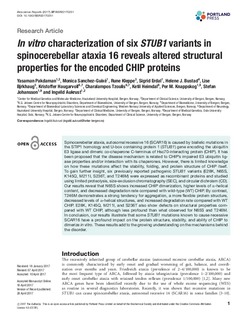| dc.contributor.author | Pakdaman, Yasaman | |
| dc.contributor.author | Sanchez Guixe, Monica | |
| dc.contributor.author | Kleppe, Rune | |
| dc.contributor.author | Erdal, Sigrid | |
| dc.contributor.author | Bustad, Helene J. | |
| dc.contributor.author | Bjørkhaug, Lise | |
| dc.contributor.author | Haugarvoll, Kristoffer | |
| dc.contributor.author | Tzoulis, Charalampos | |
| dc.contributor.author | Heimdal, Ketil Riddervold | |
| dc.contributor.author | Knappskog, Per | |
| dc.contributor.author | Johansson, Stefan | |
| dc.contributor.author | Aukrust, Ingvild | |
| dc.date.accessioned | 2019-03-11T08:48:43Z | |
| dc.date.available | 2019-03-11T08:48:43Z | |
| dc.date.created | 2017-07-04T07:54:32Z | |
| dc.date.issued | 2017 | |
| dc.identifier.citation | Pakdaman, Y., Sanchez-Guixé, M., Kleppe, R., Erdal, S., Bustad, Helene J., Bjørkhaug, L., . . . Aukrust, I. (2017). In vitro characterization of six STUB1 variants in spinocerebellar ataxia 16 reveals altered structural properties for the encoded CHIP proteins. Bioscience Reports, 37(2). | nb_NO |
| dc.identifier.issn | 0144-8463 | |
| dc.identifier.uri | http://hdl.handle.net/11250/2589493 | |
| dc.description.abstract | Spinocerebellar ataxia, autosomal recessive 16 (SCAR16) is caused by biallelic mutations in the STIP1 homology and U-box containing protein 1 (STUB1) gene encoding the ubiquitin E3 ligase and dimeric co-chaperone C-terminus of Hsc70-interacting protein (CHIP). It has been proposed that the disease mechanism is related to CHIP’s impaired E3 ubiquitin ligase properties and/or interaction with its chaperones. However, there is limited knowledge on how these mutations affect the stability, folding, and protein structure of CHIP itself. To gain further insight, six previously reported pathogenic STUB1 variants (E28K, N65S, K145Q, M211I, S236T, and T246M) were expressed as recombinant proteins and studied using limited proteolysis, size-exclusion chromatography (SEC), and circular dichroism (CD). Our results reveal that N65S shows increased CHIP dimerization, higher levels of α-helical content, and decreased degradation rate compared with wild-type (WT) CHIP. By contrast, T246M demonstrates a strong tendency for aggregation, a more flexible protein structure, decreased levels of α-helical structures, and increased degradation rate compared with WT CHIP. E28K, K145Q, M211I, and S236T also show defects on structural properties compared with WT CHIP, although less profound than what observed for N65S and T246M. In conclusion, our results illustrate that some STUB1 mutations known to cause recessive SCAR16 have a profound impact on the protein structure, stability, and ability of CHIP to dimerize in vitro. These results add to the growing understanding on the mechanisms behind the disorder. | nb_NO |
| dc.language.iso | eng | nb_NO |
| dc.publisher | Kluwer Academic/Plenum Publishers | nb_NO |
| dc.rights | Navngivelse 4.0 Internasjonal | * |
| dc.rights.uri | http://creativecommons.org/licenses/by/4.0/deed.no | * |
| dc.subject | CHIP | nb_NO |
| dc.subject | co-chaperone | nb_NO |
| dc.subject | protein aggregation | nb_NO |
| dc.subject | protein misfolding | nb_NO |
| dc.subject | ubiquitin ligases | nb_NO |
| dc.title | In vitro characterization of six STUB1 variants in spinocerebellar ataxia 16 reveals altered structural properties for the encoded CHIP proteins | nb_NO |
| dc.type | Journal article | nb_NO |
| dc.type | Peer reviewed | nb_NO |
| dc.description.version | publishedVersion | nb_NO |
| dc.rights.holder | © 2017 The Author(s). | nb_NO |
| dc.subject.nsi | VDP::Medisinske Fag: 700 | nb_NO |
| dc.source.pagenumber | 1-12 | nb_NO |
| dc.source.volume | 37 | nb_NO |
| dc.source.journal | Bioscience Reports | nb_NO |
| dc.source.issue | 2 | nb_NO |
| dc.identifier.doi | 10.1042/BSR20170251 | |
| dc.identifier.cristin | 1480625 | |
| cristin.unitcode | 203,2,10,0 | |
| cristin.unitname | Institutt for bio- og kjemiingeniørfag - Bergen | |
| cristin.ispublished | true | |
| cristin.fulltext | original | |
| cristin.qualitycode | 1 | |

